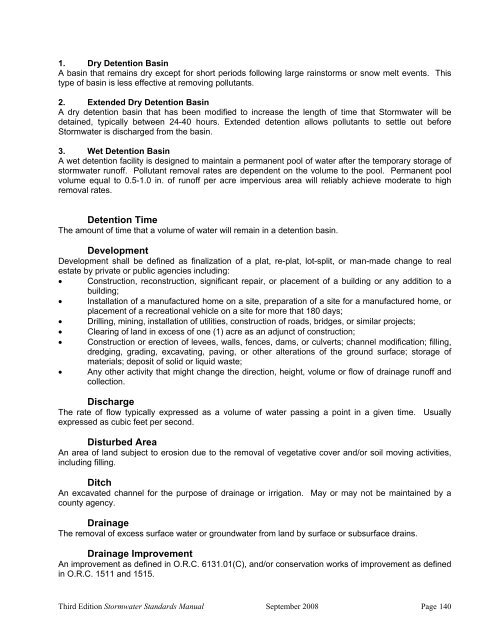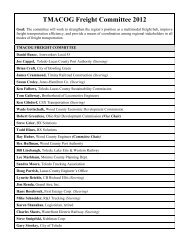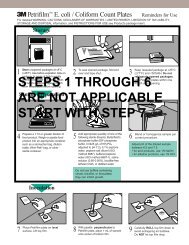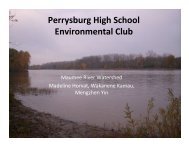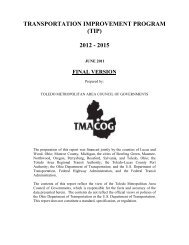Stormwater Management Standards Manual - Toledo Metropolitan ...
Stormwater Management Standards Manual - Toledo Metropolitan ...
Stormwater Management Standards Manual - Toledo Metropolitan ...
You also want an ePaper? Increase the reach of your titles
YUMPU automatically turns print PDFs into web optimized ePapers that Google loves.
1. Dry Detention Basin<br />
A basin that remains dry except for short periods following large rainstorms or snow melt events. This<br />
type of basin is less effective at removing pollutants.<br />
2. Extended Dry Detention Basin<br />
A dry detention basin that has been modified to increase the length of time that <strong>Stormwater</strong> will be<br />
detained, typically between 24-40 hours. Extended detention allows pollutants to settle out before<br />
<strong>Stormwater</strong> is discharged from the basin.<br />
3. Wet Detention Basin<br />
A wet detention facility is designed to maintain a permanent pool of water after the temporary storage of<br />
stormwater runoff. Pollutant removal rates are dependent on the volume to the pool. Permanent pool<br />
volume equal to 0.5-1.0 in. of runoff per acre impervious area will reliably achieve moderate to high<br />
removal rates.<br />
Detention Time<br />
The amount of time that a volume of water will remain in a detention basin.<br />
Development<br />
Development shall be defined as finalization of a plat, re-plat, lot-split, or man-made change to real<br />
estate by private or public agencies including:<br />
• Construction, reconstruction, significant repair, or placement of a building or any addition to a<br />
building;<br />
• Installation of a manufactured home on a site, preparation of a site for a manufactured home, or<br />
placement of a recreational vehicle on a site for more that 180 days;<br />
• Drilling, mining, installation of utilities, construction of roads, bridges, or similar projects;<br />
• Clearing of land in excess of one (1) acre as an adjunct of construction;<br />
• Construction or erection of levees, walls, fences, dams, or culverts; channel modification; filling,<br />
dredging, grading, excavating, paving, or other alterations of the ground surface; storage of<br />
materials; deposit of solid or liquid waste;<br />
• Any other activity that might change the direction, height, volume or flow of drainage runoff and<br />
collection.<br />
Discharge<br />
The rate of flow typically expressed as a volume of water passing a point in a given time. Usually<br />
expressed as cubic feet per second.<br />
Disturbed Area<br />
An area of land subject to erosion due to the removal of vegetative cover and/or soil moving activities,<br />
including filling.<br />
Ditch<br />
An excavated channel for the purpose of drainage or irrigation. May or may not be maintained by a<br />
county agency.<br />
Drainage<br />
The removal of excess surface water or groundwater from land by surface or subsurface drains.<br />
Drainage Improvement<br />
An improvement as defined in O.R.C. 6131.01(C), and/or conservation works of improvement as defined<br />
in O.R.C. 1511 and 1515.<br />
Third Edition <strong>Stormwater</strong> <strong>Standards</strong> <strong>Manual</strong> September 2008 Page 140


